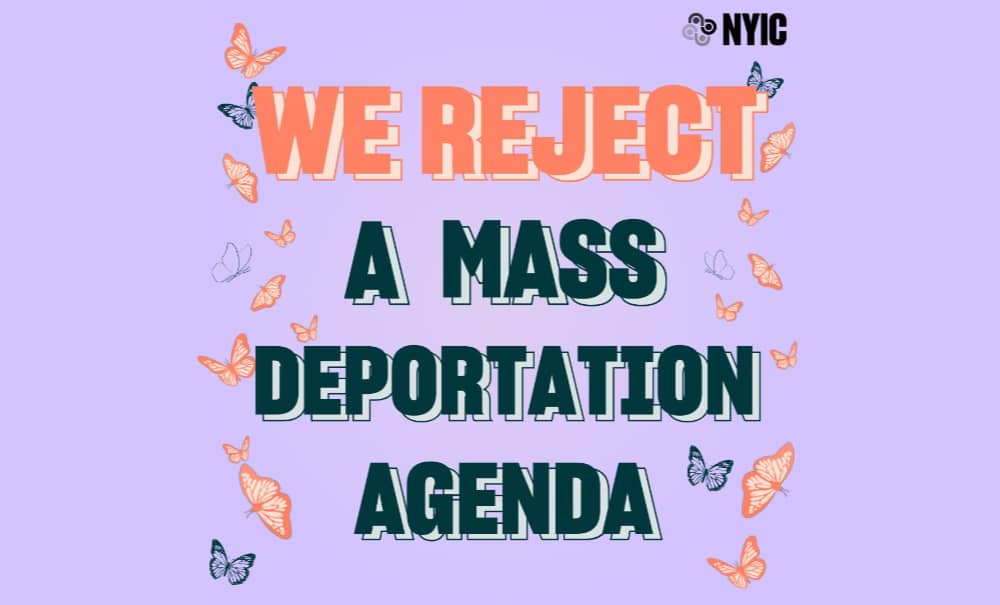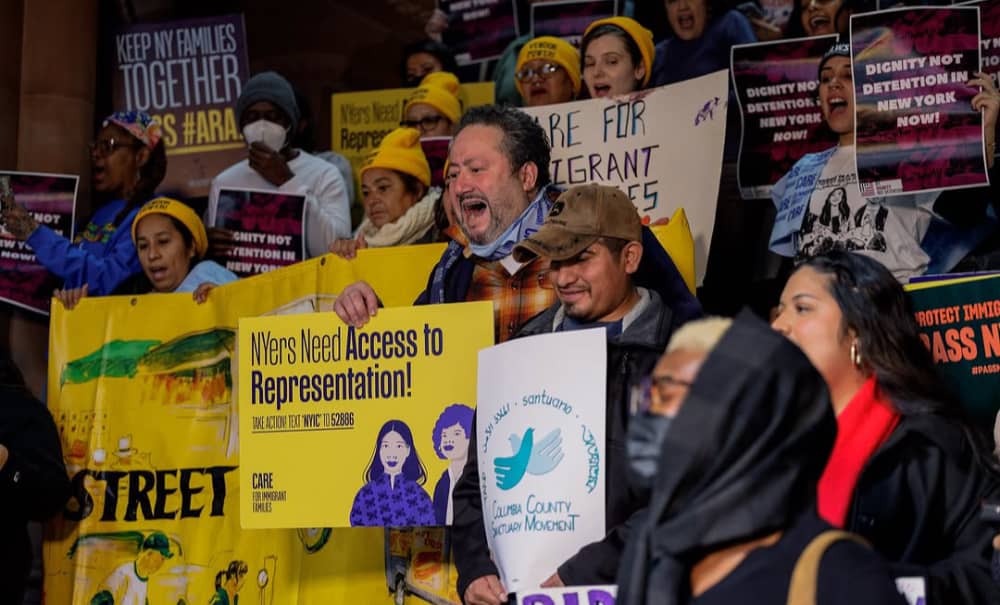
Dear friends,
As we come to the end of another tumultuous week of the new administration, we offer you a ray of hope with a link to two extraordinary examples of determination and resilience in the documentary Borderland: The Line Within. For a small fee you can follow the experiences of Gabriela, a DACA recipient from Mexico, and Kaxh, a Mayan environmental activist and asylum seeker from Guatemala, as the film exposes the extent of the Border Industrial Complex.
We also join in congratulating Make the Road New York on the opening of its newest community center this week in Corona, Queens. A ribbon-cutting ceremony attended by electeds and community members was held on Wednesday for the nearly $40 million project launched in 2016.
Today’s newsletter offers a wide-ranging look at how US cities are reaffirming their sanctuary city status in defiance of ICE threats. While NYC is not yet at the forefront of cities taking a stand, that battle is not over.
Newsletter highlights:
- Sanctuary under siege: A nationwide look at how cities fight back
1. Sanctuary Cities Protect People And Do Not Violate Federal Law
“Is it really true that if federal immigration authorities ‘command’ or ‘request’ that state officers participate in immigration enforcement, they could be prosecuted for refusing to comply? The answer is ‘no,’ and the law on the subject is quite clear.”—Just Security (01.23.25)
While the made-for-TV spectacle circulates of Dr. Phil joining an immigration raid in Chicago with ICE enforcers, a Congressional bill has been introduced that is also politically performative: it attempts to define a sanctuary jurisdiction, then makes such jurisdictions ineligible for federal funds. The funds identified for vindictive removal in this proposed bill are earmarked as being “for the benefit” of undocumented immigrants but, as the National Immigration Law Center notes: it is impossible to separate those funds from those that also benefit citizens. The bill therefore threatens funding for free school lunches, domestic violence shelters, all transportation projects, and Federal Emergency Management Agency (FEMA) funding. The new administration is making belligerent and unconstitutional threats against sanctuary jurisdictions in an attempt to bully them into abandoning the rights of the people living there. Many are standing up against the threats, while others may try to appease or benefit from Trump’s ‘transactional’ power plays.
James Comer (R-Kentucky), Chairman of the House Oversight and Government Reform Committee, recently sent letters to the Mayors of Boston, Chicago, Denver, and NYC requesting documentation from each about their sanctuary policies. Why were these cities chosen? The Mayor of Denver said he would go to jail to protect people who are undocumented; the Boston City Council recently reaffirmed its sanctuary in the Boston Trust Act; Chicago recently reaffirmed its ordinance, The Welcoming City; and New York State and City have various sanctuary provisions.
The online forum, Just Security, explains why these new demands are legally void, as were the January letter threats from Steven Miller’s America First Legal that warned of “serious consequences” over sanctuary policies. Sirine Shebaya of the National Immigration Project (NIP) concurs: “Letters like these are really more about sowing fear than they are about articulating anything that would hold up from a legal standpoint.” The NIP also published a document outlining how Sanctuary Policies Do Not Violate Federal Law. These arguments against sanctuary policies have had their day in the courts before and have lost. States can decline to help federal ICE agents because, under the Tenth Amendment, states retain police power within their own borders. They can also pursue legal remedies, support the rights of their residents to protest, and allocate funds for immigrant defense—as many did with the first Trump administration. Even the conservative Supreme Court Justice Antonin Scalia held that the framers intended states to have a “residuary and inviolable sovereignty” that barred the federal government from “impress[ing] into its service…the police officers of the 50 States.”
Republican-led cities have also expressed concern about clear responsibilities in this sweeping approach to immigration enforcement. “We understand this uncertainty creates concerns and fear,” said Oklahoma Mayor Jean Stothert, a Republican running for a fourth term, adding “Enforcing immigration law is a responsibility of federal law enforcement agencies, not the Omaha Police Department.” Indeed, the reason that Trump wants to force local police to do his will is because the 6,000 deportation officers are insufficient to handle the quota he set of 1,500 daily immigrant arrests. He needs the 800,000 law enforcement officers of the 50 states to do his bidding. So local resistance becomes crucial.
In Illinois, several Chicago community-based organizations—Brighton Park Neighborhood Council, Organized Communities Against Deportations, Illinois Coalition for Immigrant and Refugee Rights Inc., and Raise the Floor Alliance—have sued the federal government over the mass deportation raids as a violation of the Administrative Procedure Act and their First Amendment rights. They point out that Florida and Texas are not subjected to the same enforcement, even though they have three times as many undocumented immigrants compared to Illinois.
In California, in addition to San Francisco and Los Angeles city councils unanimously approving their sanctuary city policy, people gathered outside Alameda City Hall to show there is support for their existing sanctuary city status. Further South in National City hundreds of protesters gathered to voice opposition to the Trump Administration’s immigration policies and raids. The police used tear gas to disperse the crowd. Much further North in Yakima, WA, a rally in opposition to the national raids also took place, and local law enforcement agencies assured residents they would not be participating in any immigration raids.
So what of New York City? NYC Public Schools prepared staff for ICE run-ins: reminding principals that enforcement officers must have proper legal authority to access school grounds; and noting that all children have a right to education regardless of immigration status. The New York Immigration Coalition published Getting the Facts Straight on Sanctuary Cities. And Manuel Castro, New York’s commissioner of migrant affairs, has vowed not to follow “the instructions of the federal government in cases of mass deportations.”
On the other hand, NYC Mayor Adams is so far taking a conciliatory approach to Trump’s anti-immigrant actions, possibly because he is facing federal corruption charges that the notoriously transactional president could pardon. Instead of standing strong in support of New York City’s sanctuary policies, Adams said, “The American people have communicated with us loudly and clearly: We have a broken system. They want it fixed. We need to fix our immigration system. We need to secure our border”. He added: “I’m not going to be warring with this administration. I’m going to be working with this administration.”
As truthout, a member of the important Movement Media Alliance, reported:
“A bully will hit you and then tell you that you made them hit you. Local elected officials and communities must not give in to Trump’s bullying and obey in advance, which will only set a dangerous precedent and groundwork for targeting and persecution of organizers, lawyers, advocates, and others working to protect immigrant communities.”
WHAT CAN WE DO?
- Join the Vera Institute of Justice in pushing NY State elected officials to protect immigrant New Yorkers by passing the New York for All Act, Dignity Not Detention Act, Access to Representation Act, and Clemency Justice Act.
- Circulate United We Dream’s resources, including Know Your Rights information sheets.
- Check out the TV show ‘Mo’ about an asylum-seeking Palestinian family living in Texas – this fictionalized account shows the humanity of the people that Trump wants to deport.
- Be healthy and support immigrants by signing up for the Immigrants Run NYC, For The Love of Queens, 5k run in Flushing Meadows Park on February 15. Queens Distance Runners are donating 50% of the registration fees to NICE.
In solidarity and with collective care,
Jackson Heights Immigrant Solidarity Network (JHISN)
Follow @JHSolidarity on Facebook and Twitter and share this newsletter with friends, families, neighbors, networks, and colleagues so they can subscribe and receive news from JHISN.
